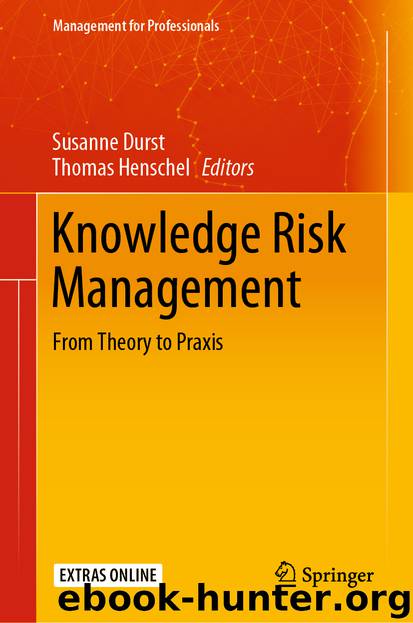Knowledge Risk Management by Susanne Durst & Thomas Henschel

Author:Susanne Durst & Thomas Henschel
Language: eng
Format: epub
ISBN: 9783030351212
Publisher: Springer International Publishing
5 Knowledge Transfer
The tacit character of knowledge increases knowledge retention risks for the companies because it is not easy to formalize and transfer. On the other hand, without knowledge transfer and making it more accessible by other employees, companies are vulnerable to the loss of knowledge if their employee left the job (Lee et al. 2014). Or, their outsourcing contractor walks out with the knowledge needed to perform business operations (Agndal and Nordin 2009). Therefore, organizations concerned with their knowledge assets need to find feasible methods to knowledge transfer to keep their knowledge assets in their organization.
Employing blockchain developers or finding a highly professional external contractor qualified in the blockchain are not enough to keep their knowledge assets in the organization. It needs to be internalized by the organization to maintain blockchain operations in their absence.
The first method to ease knowledge transfer is engaging with the blockchain developer or contractor using different communication channels and regularly scheduled meetings. The major reason for closer interaction is generally in the blockchain market developers and contractors are offered remote jobs (Blockgeeks 2018). This may be challenging for many companies who are not familiar with this employment model because of the feeling that has no control over the situation and difficulties to gain trust with a remote team (Forbes Coaches Council 2018). The location flexibility provided for remote employees may cause a problem for many companies to transfer the tacit knowledge to an organizational asset. On the other hand, this model of employment can turn into an advantage because companies who hire blockchain developers no need to provide office, insurance or meals for their employees that can reduce their employment cost. Furthermore, too much intervention to their business may reduce their job motivation (Interview_2). For these reasons, regular social interaction and tasking mechanisms can improve knowledge monitoring mechanisms between organization and expert that can enable knowledge exchange (Massingham 2010).
The second method for knowledge transfer is defining the valuable employees whose knowledge needs to be transferred (Massingham 2008) and teaming up these high-skilled employees with less-experienced workers (Rappaport et al. 2003). Otherwise, in the absence of teamwork, there is a risk of losing knowledge when a valuable employee quits the job. This mentor and apprentice model may be formed between employees of external contractor and indigenous workforce (Interview_3). The higher level of interaction between team members combined with the mentoring role of skilled workers creates a common knowledge within the team, and it can be transferred by other employees as organizational knowledge (Durst and Bruns 2016). For the companies considering to adapt blockchain, creating a blockchain team is one of the options to encounter the risk of knowledge loss. The experienced blockchain developer both inside and outside of the company can be paired with other software developers or technicians to maintain a blockchain project. As knowledge sharing improves and other members of the team learn developing and maintaining the blockchain, critical knowledge dependency of the company will diminish to certain employees or external contractors.
The third
Download
This site does not store any files on its server. We only index and link to content provided by other sites. Please contact the content providers to delete copyright contents if any and email us, we'll remove relevant links or contents immediately.
| Automobile | Business |
| Casualty | Health |
| Liability | Life |
| Property | Risk Management |
The Secrets of Successful Financial Planning by Dan Gallagher(1517)
A Knight's Reward by Catherine Kean(1329)
An American Sickness by Elisabeth Rosenthal(1250)
Against the Gods by Peter L. Bernstein(1102)
FREAKONOMICS by levitt steven d(1089)
SuperFreakonomics by Steven D. Levitt(1075)
America's Bitter Pill: Money, Politics, Backroom Deals, and the Fight to Fix Our Broken Healthcare System by Steven Brill(1074)
America's Bitter Pill by Steven Brill(1051)
Risk Management Framework by James Broad(1026)
The Globetrotter's Guide to Travel Insurance: Travel Smarter, Pay Less, Get the Right Coverge (The Savvy Traveler Series Book 1) by Bauche Michael & Bauche Yvonne(1024)
A Practical Introduction to Security and Risk Management by Bruce Oliver Newsome(1022)
2019 Social Security & Medicare Facts by Michael D. Thomas(1017)
Strategic Risk Taking: A Framework for Risk Management by Aswath Damodaran(1011)
The New Frontier Investors by Jagdeep Singh Bachher Adam D. Dixon & Ashby H. B. Monk(1005)
Game Changers by Rudolf Taschner(1002)
How Our Days Became Numbered: Risk and the Rise of the Statistical Individual by Dan Bouk(995)
The 8 Characteristics of the Awesome Adjuster by Carl van Lamsweerde(928)
SUPERFREAKONOMICS by levitt steven d(922)
The Advisor Playbook: Regain Liberation and Order in your Personal and Professional Life by Duncan MacPherson & Chris Jeppesen(885)
